The Red Cathedral Review
Let’s get one thing straight—the box may be small, but The Red Cathedral is anything but minor. Designed by Sheila Santos and Israel Cendrero and published by Devir, this eurogame invites players to step into the boots of ambitious architects in 15th-century Moscow, racing to gain the Tsar’s favor by constructing the majestic cathedral that will one day bear Ivan the Terrible’s legacy.
What is The Red Cathedral?
At its heart, The Red Cathedral is a tight and highly strategic resource management and area control board game. Each player competes to contribute the most prestigious sections to the great cathedral, combining dice-based resource gathering with smart tile placement and modular scoring. Despite its compact packaging, this game delivers the depth and tension of a full-sized euro.
Players draft and place dice to claim resources, spend them to build cathedral sections, and manage their influence with powerful guilds and clergy to manipulate the market or gain critical advantages. The clever twist? The same dice you use to gather resources also influence which actions are available—making every turn a puzzle in timing, efficiency, and long-term planning.
🧱 Player Count: 1–4 players
🕰️ Playtime: 60–80 minutes
🎯 Complexity: Medium+
⚙️ Core Mechanics: Dice drafting, engine building, modular board, resource management
🏛️ Theme: 15th-century Russian cathedral construction
Let’s lay the first stone and welcome The Red Cathedral to the interview.
Simplicity That Elevates Strategy: Building Begins With a Blueprint
Me: Welcome to the table, The Red Cathedral. I must say, for a game with such a monumental subject—cathedral construction in 15th-century Moscow—you certainly wear your rules lightly.
The Red Cathedral: Thank you kindly. Every cathedral begins with a solid foundation, and mine is a structure of simplicity. On each turn, players may choose from just three actions: claim a section of the cathedral, gather resources using the dice rondel, or build a section using the resources they’ve collected. That’s it.
Me: That’s refreshingly lean, especially for a eurogame.
The Red Cathedral: Precisely. I don’t burden players with complexity for complexity’s sake. Instead, I guide them toward mastery through elegance. You learn quickly what each action does, which means you’re not fumbling with the rulebook. You’re planning, strategizing, and building—like any good architect should.
Me: So when does the game deepen?
The Red Cathedral: Almost immediately. You’ll start thinking not just about what to do, but when to do it. How far around the rondel should you move? Is it time to commit to a section? Should you delay to stockpile resources—or claim a valuable section before your rival snatches it? These small decisions become crucial.
Me: So your simplicity unlocks depth?
The Red Cathedral: Exactly. My compact ruleset allows the strategic tension to shine. You stop asking “how do I play?” and start asking “how do I outbuild the others?” That’s when the real architecture begins.
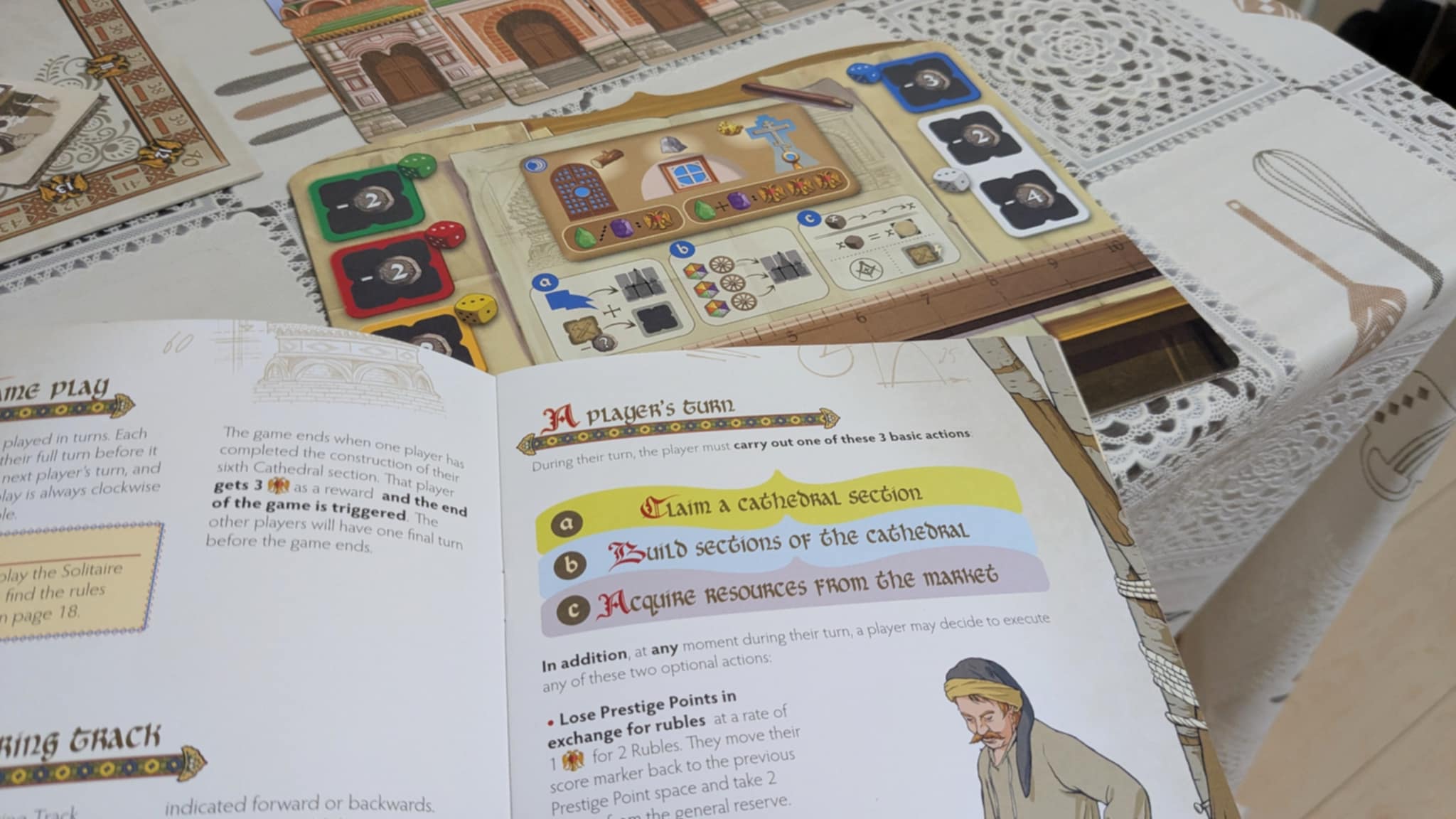
Timing and Efficiency: How a Well-Placed Brick Builds a Legacy
Me: So, The Red Cathedral, you’ve told us about your simple actions and lean structure. But how do players rise from apprentice to master architect?
The Red Cathedral: Ah, that’s where timing and efficiency come into play. You see, each of my actions may be simple, but their impact is all about when and how you use them. Every decision is a small puzzle—an opportunity to squeeze more value out of the same action.
Me: Can you give an example?
The Red Cathedral: Certainly. You could claim a section of the cathedral now… or wait a little, save up some rubles, and unlock a banner tile for your workshop—adding ongoing benefits and streamlining your future builds. That same delay might allow you to line up resources with a bonus action, giving you a little boost just when you need it.
Me: So even the bonus quadrant actions aren’t just decorative?
The Red Cathedral: Far from it. They’re the scaffolding for clever play—tiny effects, yes, but if you time them right, they’re the push that turns a good turn into a great one. Grab two wood instead of one. Push a die just one space further. Suddenly, you’ve built faster, earned more favor, and edged out your rival by a single glorious point.
Me: And that endgame rush?
The Red Cathedral: It’s a final crescendo. Once someone completes their sixth section, the hammer falls. Everyone has one last chance to grab those roof tiles, drop a cross, or cash in that final bonus. The tempo quickens, the pressure rises—and that’s when the architects shine.
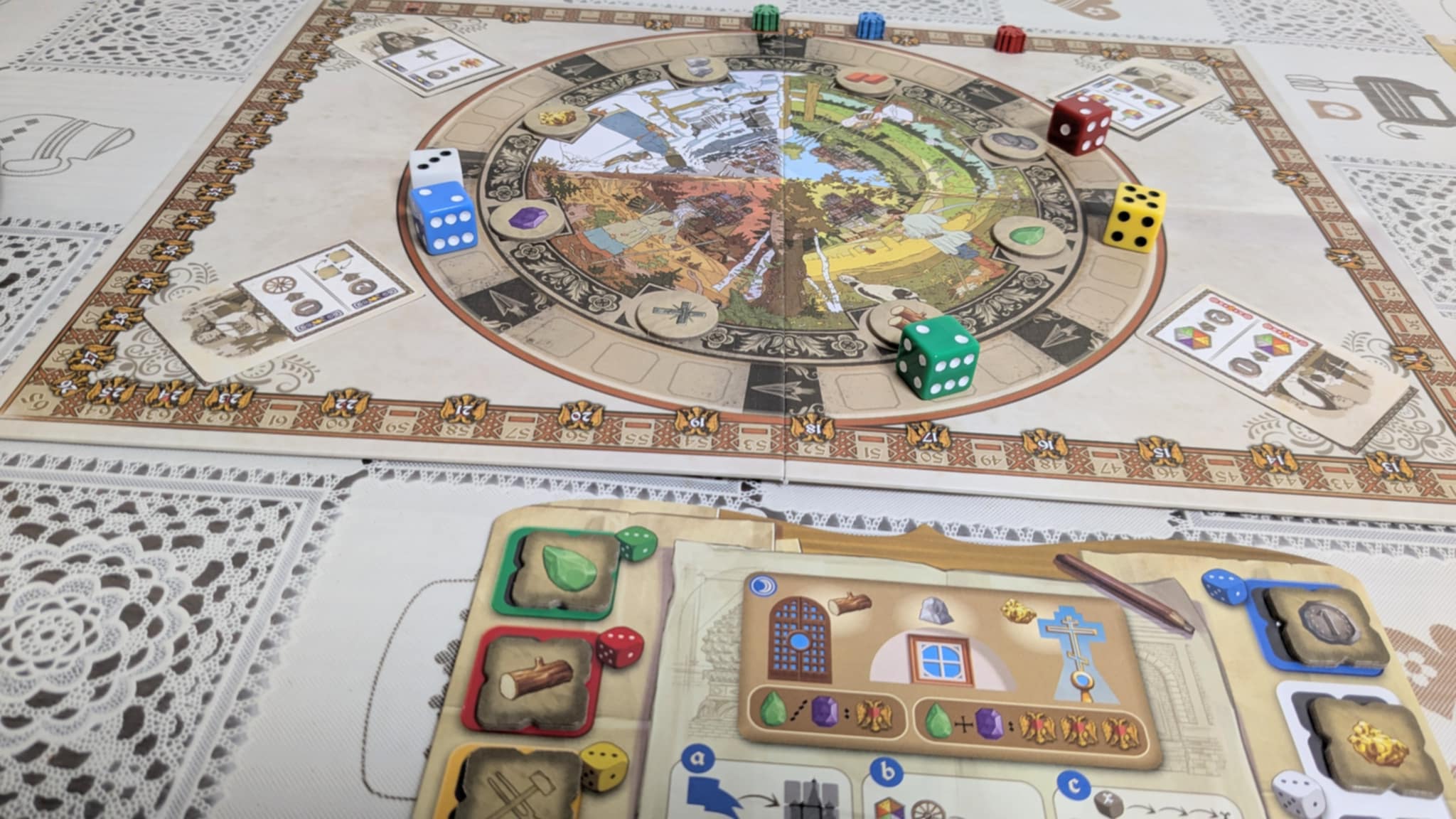
Balancing the Scoring Tracks in The Red Cathedral: Recognition vs. Prestige
Me: Let’s talk about your scoring system. Two tracks in one game—why the duality?
The Red Cathedral: Because building a cathedral is not just about recognition—it’s about prestige. I feature two intertwined scoring tracks: recognition points (the standard scoring) and eagle points (prestige points). The clever twist? These two merge into one track, but the value of each type of point shifts throughout the game.
Me: That sounds subtly strategic. How does it affect how players score?
The Red Cathedral: Early on, every eagle point is worth 3–4 recognition points. But as the game progresses, that value slowly normalizes—eventually becoming a 1:1 exchange. This shift means that eagle points are far more valuable in the early game, and standard recognition points matter more in the closing rounds.
Me: So, it changes how players approach scoring?
The Red Cathedral: Exactly. Here’s where it gets interesting—regular points mostly come from building cathedral segments, while eagle points come from ornate adornments. However, you can’t build an adornment unless the segment below it is finished. So, the very structure of the game pulls players between short-term strategy and long-term efficiency.
Me: And I imagine players can interfere with each other?
The Red Cathedral: Absolutely. Watch your opponents. If they’re racing for an early adornment slot or stacking up prestige-rich gems, that might be your cue to pivot. Timing, interaction, and a dash of opportunism—it’s all part of becoming the czar’s favored architect.
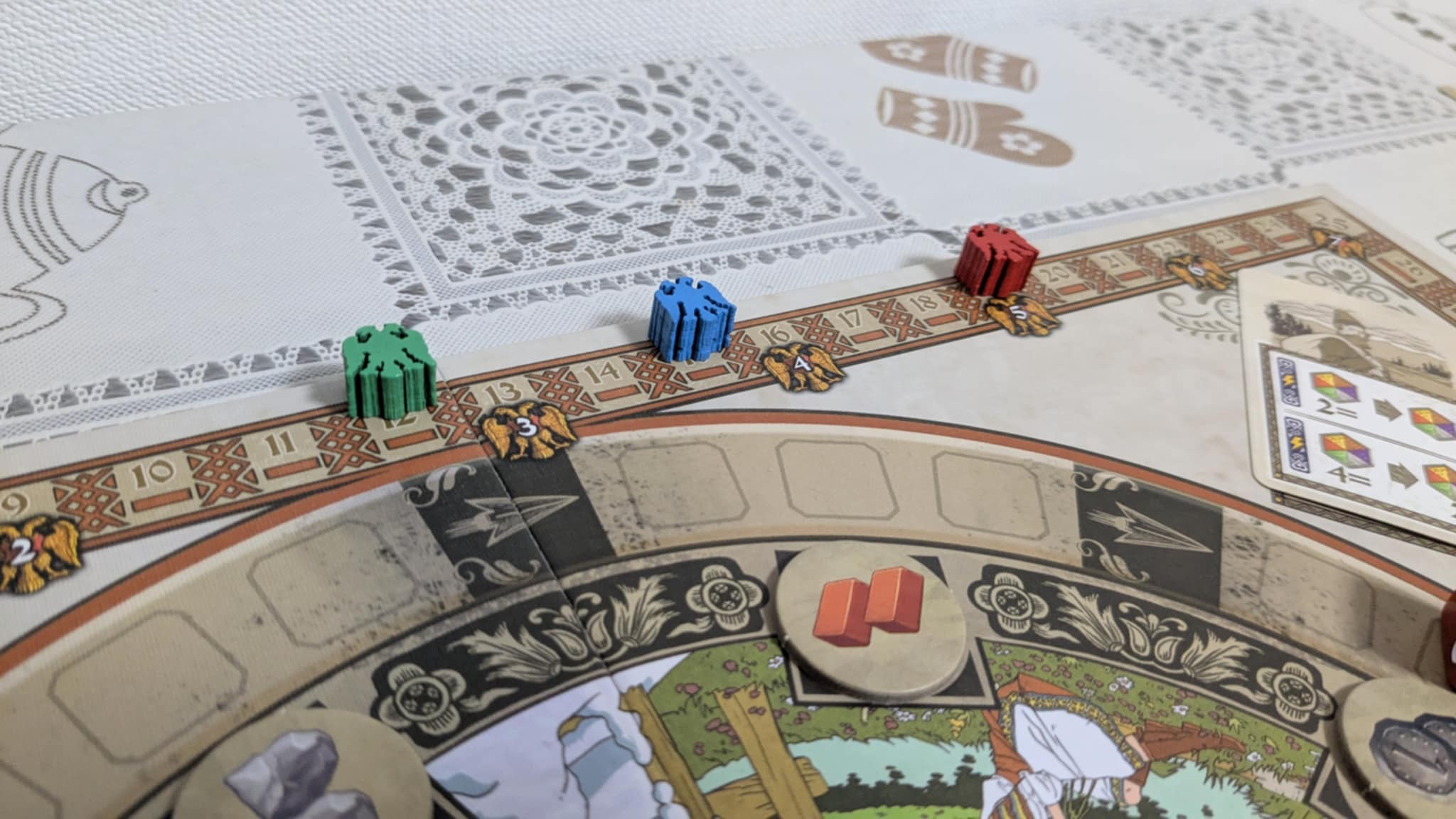
Strategic Trade-Offs: Spending Prestige for Power in The Red Cathedral
Me: Earlier, you mentioned the brilliance of your scoring system. But there’s another layer to it, isn’t there?
The Red Cathedral: Indeed. That clever valuation of eagle points doesn’t just impact how you score—it also fuels my special actions. These aren’t part of the standard turn structure, but they can be executed at any time… for a price.
Me: And that price is… prestige?
The Red Cathedral: Precisely. You can spend eagle points—those valuable early-game multipliers—to gain rupples or reroll the dice in a quadrant of the rondel. This adds a thrilling micro-economy to the game. Do you burn a prestige point to grab that last ruby or adjust an inconvenient die, potentially setting up a high-efficiency play? Or do you hoard them for a stronger final score?
Me: That seems like another layer of tension. Especially if you spend early.
The Red Cathedral: That’s the heart of the matter. Early on, when eagle points are most valuable, your need for resources and flexibility is also at its peak. This puts players in a delicious bind. Spend too much prestige and you weaken your scoring engine. Spend too little and your tempo might stall.
Me: So eagle points become both victory and velocity?
The Red Cathedral: Well said. They’re fuel—and using them well at just the right moment can catapult your strategy ahead. The beauty is in reading the board, reading the timing, and knowing when a single reroll could secure an entire cathedral section. These are the trade-offs that separate a humble apprentice from the czar’s master architect.

Column Control: The Subtle Art of Stealing the Spotlight
Me: All this resource management, point juggling, and rondel-rolling is fascinating—but how does it all come together in the end?
The Red Cathedral: Ah, now we arrive at the grand finale—the cathedral itself. As players claim and complete segments, they are not only building upward, but also locking horns in a quiet tug-of-war over entire columns.
Me: So it’s not just about what you build, but where you build it?
The Red Cathedral: Exactly. At the end of the game, each column of the cathedral awards bonus eagle points to the player who contributed the most. That means bricks alone don’t win—position and timing matter. You might finish two sections of a tower, and just when you think you’ve sealed it… your rival slips in an ornament. Suddenly, they’ve stolen the spotlight—and your column.
Me: That must make each placement feel much more loaded.
The Red Cathedral: It does. And here’s the clever part—these aren’t just minor bonuses. A well-timed arch, window, or cross can tilt the entire outcome. Even a low-value adornment might secure dominance if it tips the balance in your favor.
Me: I see now—this is where your eurogame roots really show. It’s indirect competition, but the stakes are very real.
The Red Cathedral: Precisely. Many modern eurogames get so caught up in solo engine building that they forget the most vital ingredient: your opponents. My column scoring ensures you’re never playing in a vacuum. You’re building, yes—but you’re also watching, planning, and scheming. Because when that final tally hits, every wooden door matters.
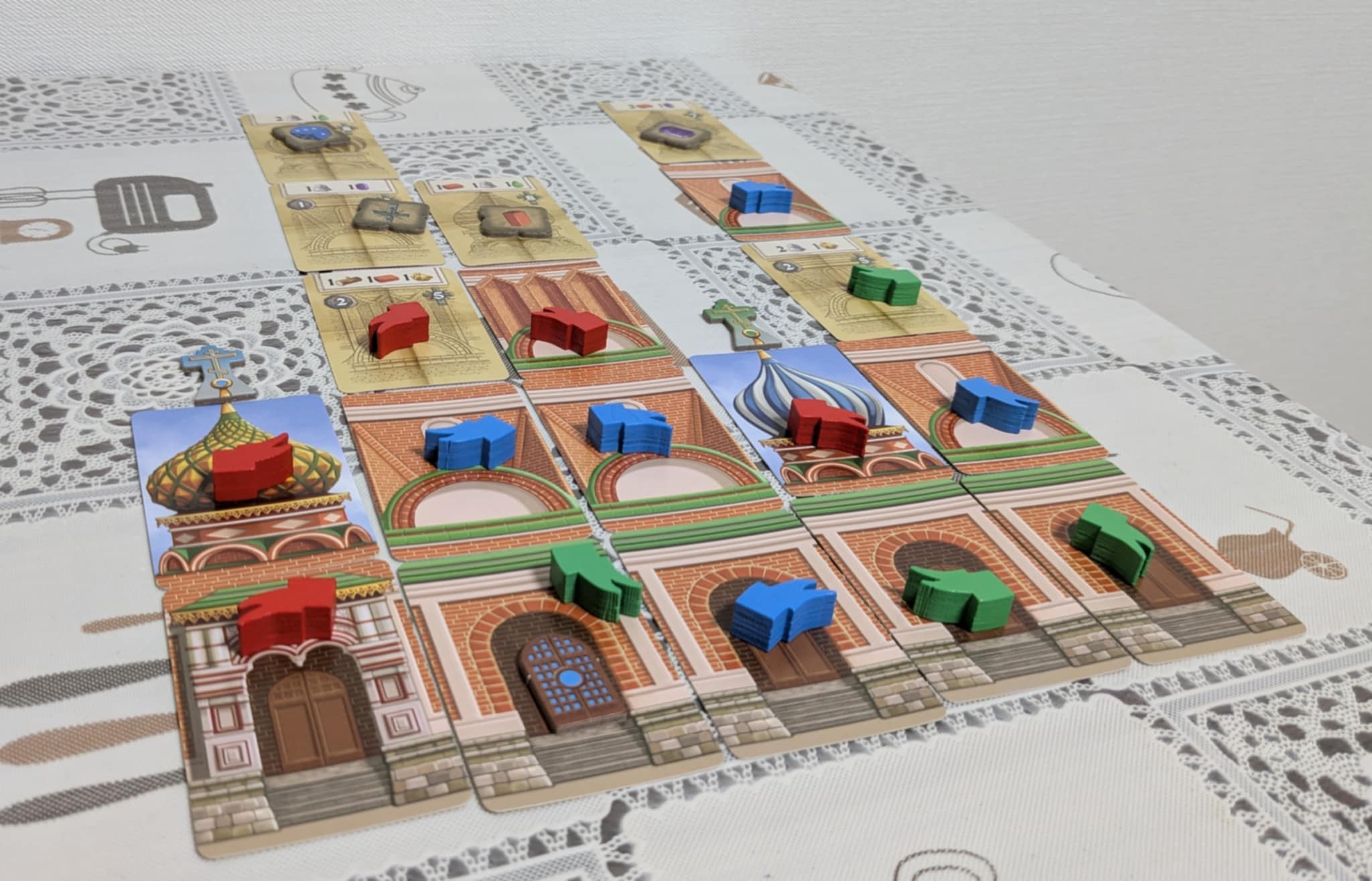
Minor Flaws in an Otherwise Grand Design
Me: You’ve certainly made a strong case for your efficiency and elegance—but no cathedral is without its cracks. What would you say are your weakest stones?
The Red Cathedral: A fair question. My rondel is a highlight for many, but it does introduce a degree of randomness that doesn’t always sit well. In a game so dependent on timing and precision, the roll of the dice can shift the landscape dramatically—sometimes to a player’s advantage, other times to their downfall.
Me: So if I’m planning a big turn and someone rerolls the dice right before me, my whole strategy could fall apart?
The Red Cathedral: Precisely. It adds tactical tension, but it also shifts focus away from long-term strategy. I am a game about seizing moments, not building sandcastles over ten turns. Some may love that urgency—others may find it a bit too reactive.
Me: I also heard that leaving a segment unfinished comes with a point penalty?
The Red Cathedral: Yes, that’s true. If others complete segments above yours, you’ll lose points. In theory, it’s a sharp prod to keep players moving. But in practice, it’s far more punishing early on, when a single lost point can mean losing a full eagle point. By mid to late game, the penalty feels toothless, and some might even forget it exists.
Me: And the final scoring?
The Red Cathedral: The column control bonuses are rich with interaction, but I admit—they come with a pinch of extra rules weight that stands out in an otherwise crisp design. It’s a small blemish, but worth noting for those drawn to ultra-clean eurogames.
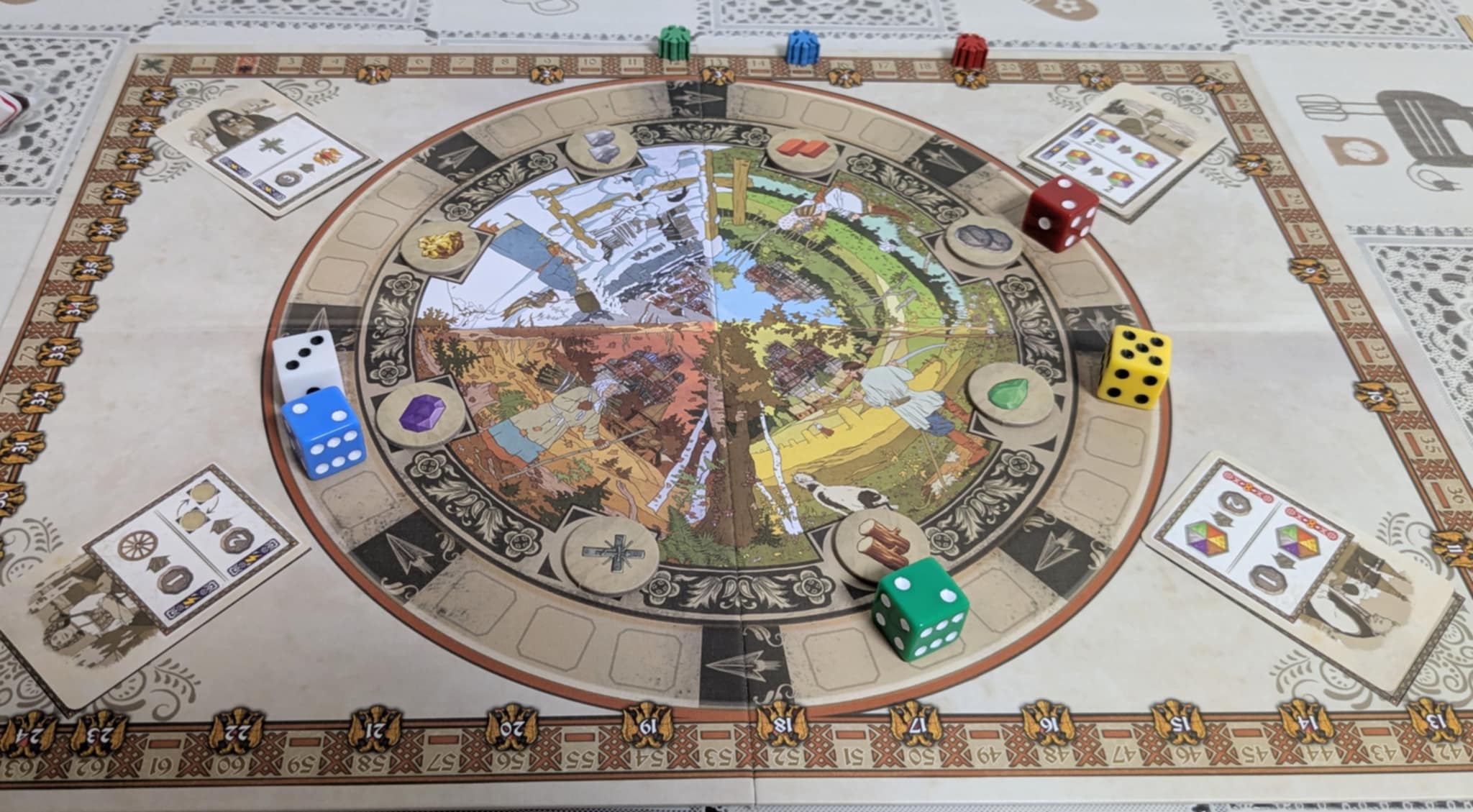
Final Verdict: A Monumental Game in a Modest Box
Me: Before we close the gates to the cathedral, any final words you’d like to leave with our readers?
The Red Cathedral: Only this—don’t let my small frame fool you. I may not come with piles of tokens or sprawling boards, but within my walls lies a deeply rewarding experience. I’m built on the bones of classic eurogame structure—tight timing, clever efficiency, indirect interaction—and I strive to keep those foundations pure.
Me: That’s certainly come through. You offer resource management, strategic pressure, and player engagement with very little fat on the design.
The Red Cathedral: Thank you. I focus on the essentials. The rondel keeps players constantly engaged, the dual scoring tracks create shifting incentives, and the column control adds that extra edge of competition. I reward players who can think ahead, adjust quickly, and seize fleeting opportunities.
Me: For fans of light to medium-weight eurogames, you’re a shining gem. And with modular setups and varied strategies, there’s plenty of reason to return to your construction site again and again.
The Red Cathedral: That’s the goal. For those who appreciate elegance, tension, and strategic depth in a streamlined package—I’m always ready to build something special with you.
Me: Thank you for joining us, Red Cathedral. May your towers rise proudly on many a table.
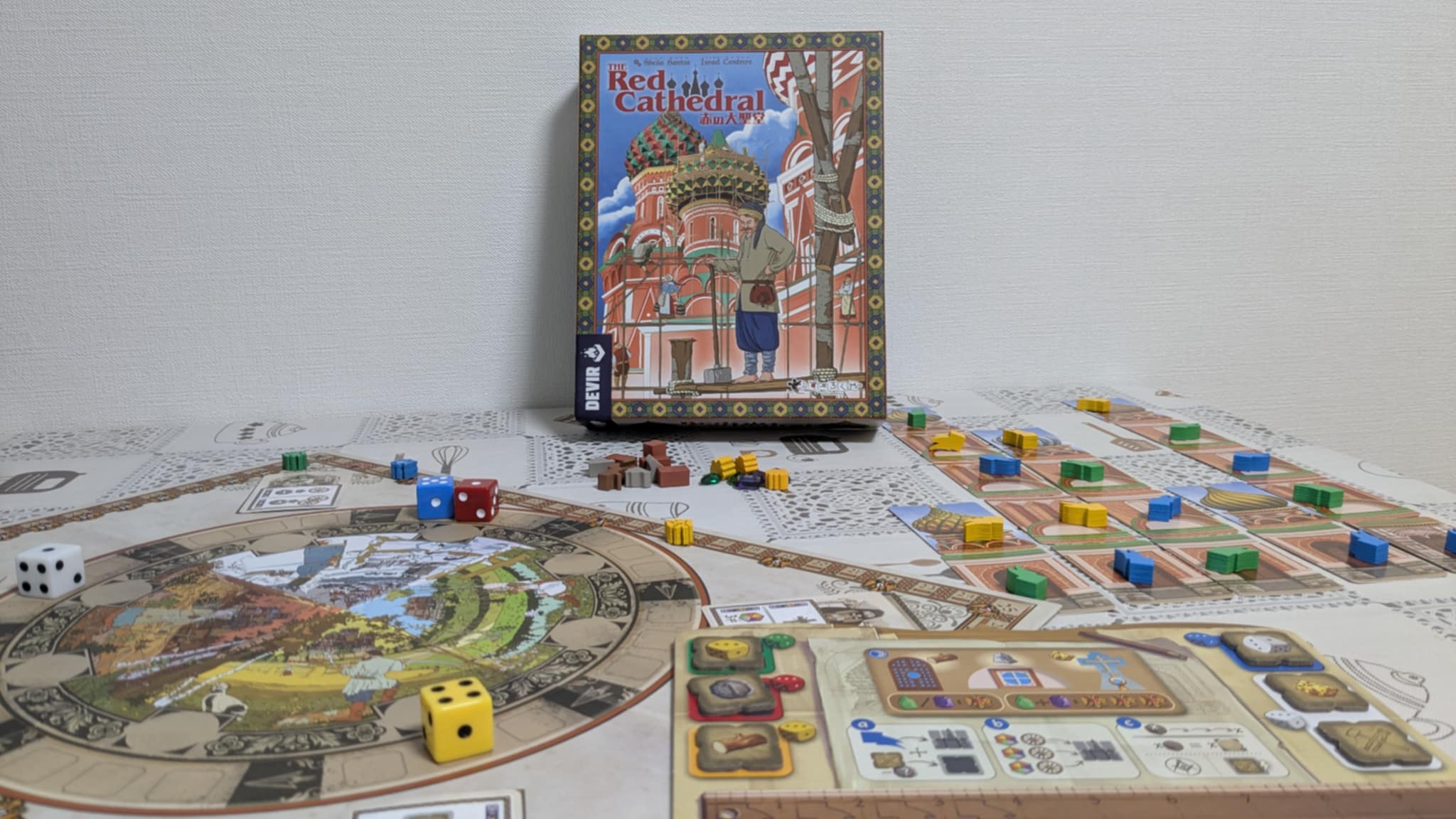
Conclusion
The Red Cathedral is a shining example of how a small-box eurogame can deliver a rich, strategic experience without excess. With elegant mechanics built around timing, efficient resource use, and subtle player interaction, it captures the spirit of traditional eurogames while offering a streamlined modern presentation. The game rewards those who can adapt, calculate, and make the most of every round, all within a compact playtime and footprint. For anyone who enjoys clever efficiency puzzles and satisfying indirect competition, The Red Cathedral is an absolute gem. Highly recommended.
Alternative Recommendations:
If you enjoy streamlined eurogames like The Red Cathedral, consider Caylus 1303, a reimagined worker placement classic with smooth progression and tough choices. For something lighter but equally deep, Through the Desert is a timeless game of territory control with simple rules and lasting impact. If you’re craving more indirect player interaction and personal board strategy, Hansa Teutonica offers one of the most rewarding experiences in all of eurogaming.
Final Rating: 9/10
Pros:
- Simple but deeply strategic
- Excellent timing-based gameplay
- Strong indirect player interaction
- Huge replayability in a small package
Cons:
- Resource randomness can swing turns
- Weak penalty for segment delays
- Endgame scoring feels slightly tacked on compared to the rest
A modern euro that honors the genre’s roots while staying focused—The Red Cathedral is a triumph in compact design.

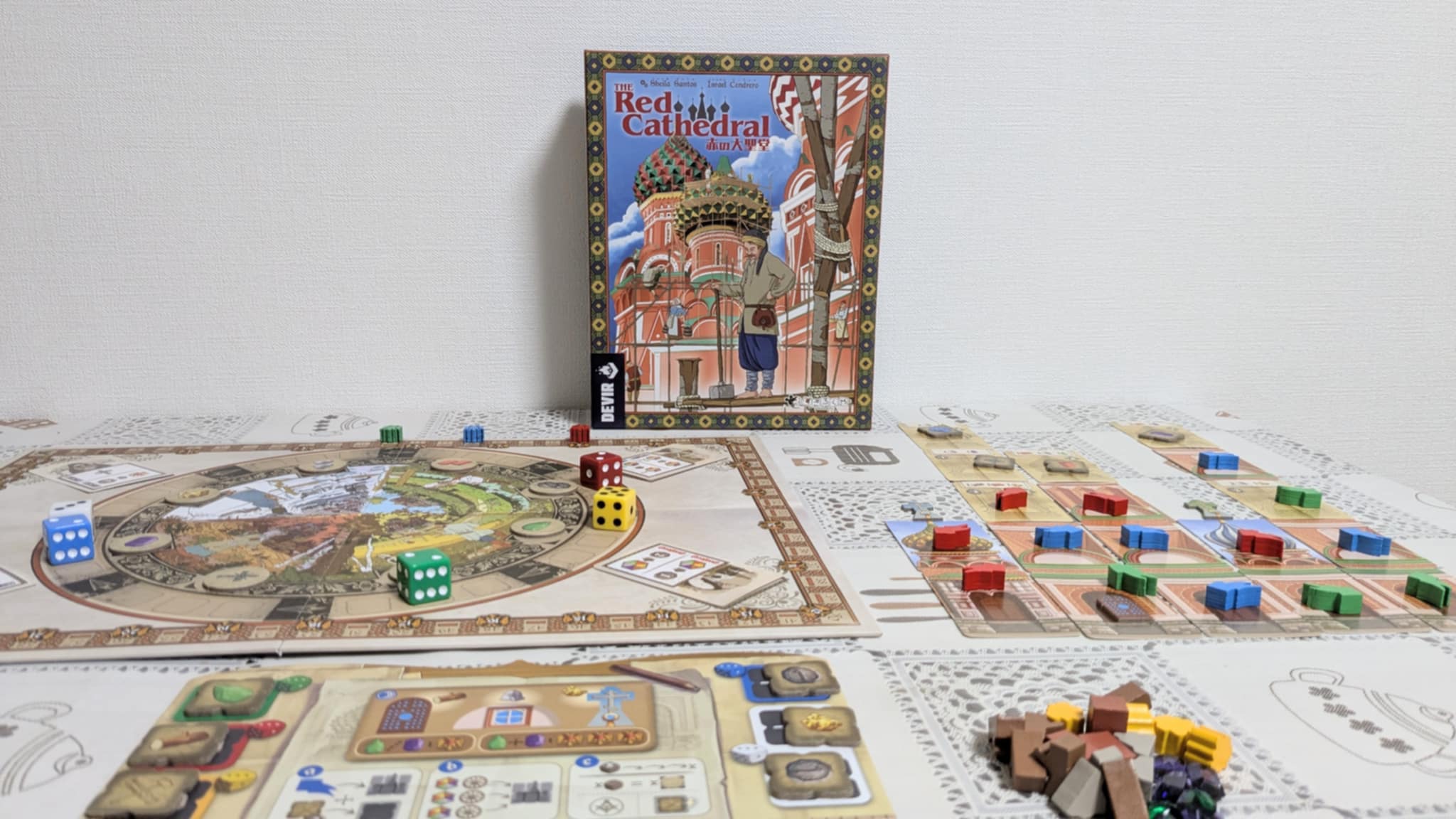
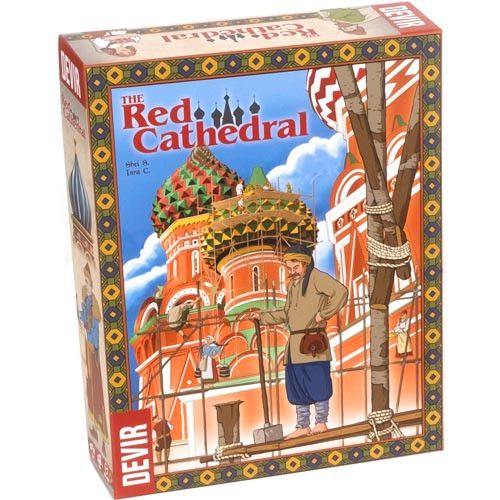


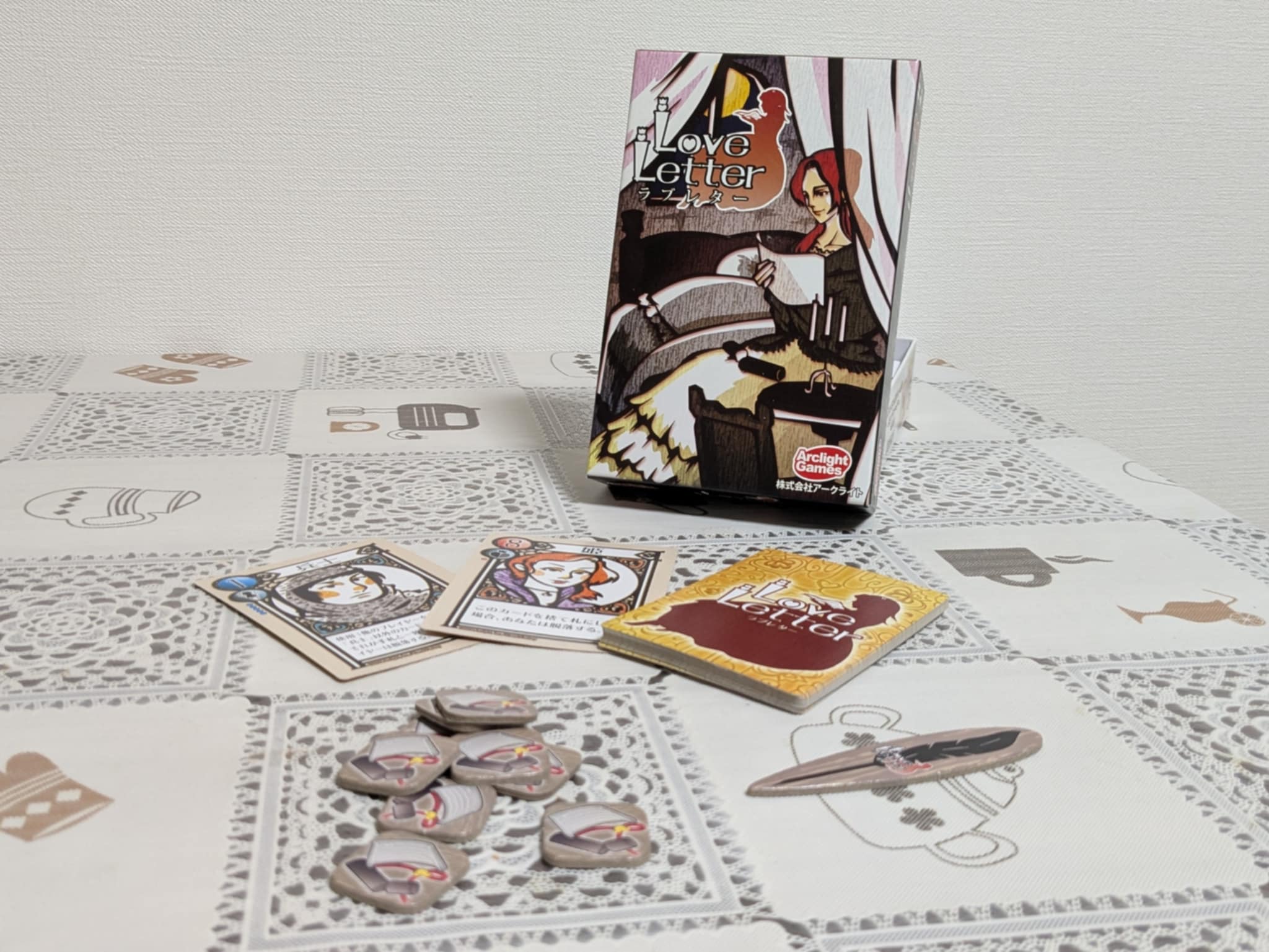
Leave a Reply